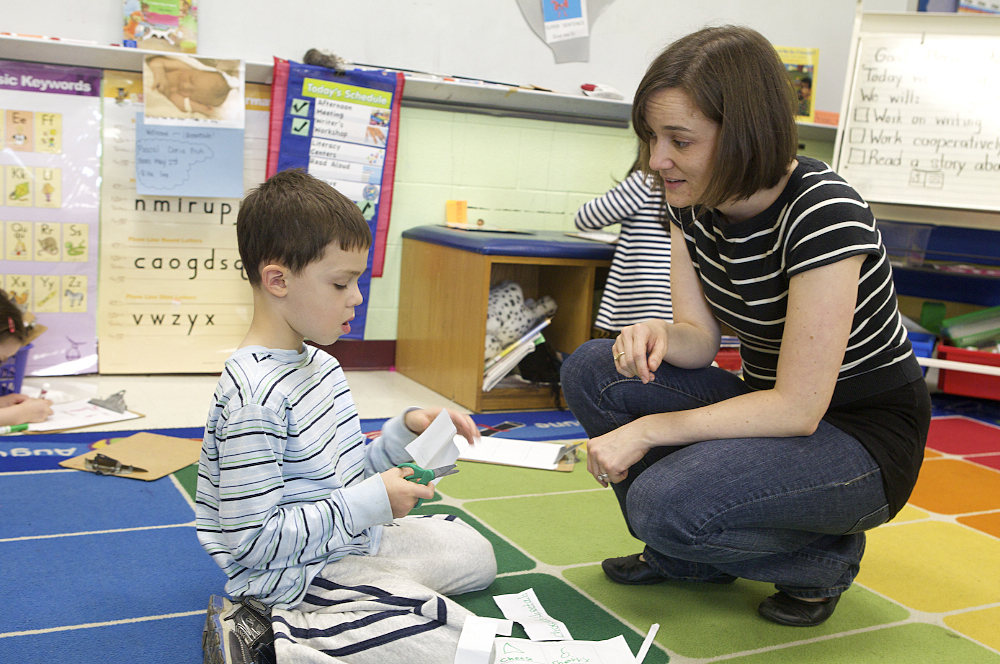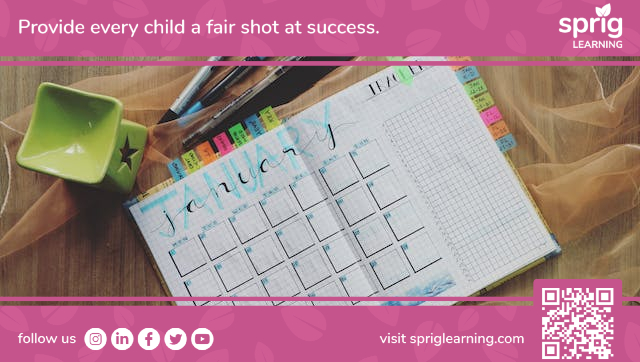There are an average of 36 weeks in a school year.
Each week is an opportunity for teachers to deliver explicit instruction and assess the specific foundational skills that support every child to grow as a young reader.
The span of a week provides teachers with the ideal unit of time to delve into specific reading skills, creating an environment for students where they can absorb and apply these skills as a learner.
Proper planning and execution of weekly teaching activities throughout the school year results in positive outcomes for students.
A meticulous teaching process that is repeated week in and week out ensures that students receive a well-thought-out educational experience. It contributes to their overall literacy growth and development.
When teachers create a weekly plan infused with research-backed early literacy strategies, it ensures a dynamic and effective learning experience.
Weekly plans can keep students engaged in learning essential concepts, while allowing flexibility to address individual learning needs and take appropriate next steps.
If you’re eager to explore a comprehensive list of research-backed and proven foundational reading skills, check out this detailed article on the Sprig blog. It covers each foundational skill, providing insights into their importance and citing supporting evidence.
This article covers how classroom teachers can master the assessment, instruction and re-assessment of foundational reading skills on a weekly basis.
What is Weekly Planning? With A Scenario.

Weekly planning for teachers involves the strategic organization of instructional activities, lessons and assessments for the upcoming week.
The activities done in any one week can change over the course of the term.
While school and class contexts can differ widely, the following scenario provides a detailed view of what effective weekly planning looks like as a term progresses:
The first week serves as a dynamic introduction, encompassing foundational reading skills such as reviewing alphabet knowledge and phonics or refreshing concepts from the previous school year.
Simultaneously, targeted explicit instruction is provided on chosen skills, accompanied by assessments to gauge student comprehension.
Subsequent weeks shift focus to the review and adjustment stage, analyzing assessment data to distinguish skills that students have mastered and skills that are proving challenging for certain students.
Challenging skills are revisited through whole-class instruction, ensuring a comprehensive understanding.
As teachers progress through the weekly planning framework, small-group instruction becomes pivotal for students who require extra practice. Skill segmentation is adopted, allowing educators to differentiate between whole-class needs and those of individual learners.
For students with multiple skill deficits, individualized support and potential interventions are explored. Team collaboration with the early literacy team is emphasized, providing a platform to discuss individual student needs and design effective support strategies based on a thorough understanding of each student’s context.
Addressing knowledge gaps extends support to students falling behind while simultaneously assisting those not significantly behind but still requiring additional help.
The creation of practice centers becomes essential for skills demanding extensive practice, offering targeted doses to enhance skill proficiency.
In instances of significant skill gaps, a blitz intervention strategy can be initiated, quickly addressing multiple knowledge deficiencies via reading strategies over a short period of time.
During this time, alternative support mechanisms like parental involvement or peer pairing can also be explored.
Exploring various strategies within the realms of tier 1 and tier 2 instruction offers ample opportunities for intervention before resorting to tier 3 assistance, which often involves significant resource allocation.
Regularity and Intentionality of Weekly Planning

While the previous section covered what weekly progression may look like, there are many constants which are practiced every week by educators.
Such regular and intentional practices help to build an effective formative assessment culture.
Two such very important practices are maintaining a weekly assessment routine, and a follow-up schedule.
Assessment Routine
The assessment routine becomes a structured part of the teacher’s week. Data-driven insights gleaned from these assessments guide modifications in teaching practices.
Purposeful learning design ensures that chosen activities align explicitly with the content students need.
They offer ample practice opportunities before subsequent assessments, which compose the follow-up schedule.
Follow-up Schedule
The establishment of a follow-up schedule ensures regular tracking of skills for all students, highlighting the importance of progress monitoring as a foundational aspect of the early literacy strategy.
A Template for Mastering Weekly Planning

Depending on the assessment cycle—whether it’s the initial assessment, reassessment, introduction of differentiated instruction, or reassessment of—teachers need to tailor their actions for the week accordingly.
Using the information above the weekly planning section, the following template is provided for mastering weekly planning.
It’s a task-based template, where one or more of the following tasks might have to be completed in a week, based on the advancement of the particular school term in question.
Skill Selection
In-Depth Analysis: Teachers conduct a detailed analysis of foundational skills, checking for alignment with grade levels.
Differentiated Start: The first week’s focus varies, either introducing new skills or reviewing concepts from the previous term/year.
Instruction and Assessment
Simultaneous Approach: Teachers integrate explicit instruction with real-time assessments during the week.
Immediate Feedback: Instant feedback guides adjustments in teaching strategies.
Whole-class Instruction
Data-Driven Reflection: Classroom performance is measured against set benchmarks and compared to other classrooms at the same grade.
Identifying Challenges: Skills that pose challenges are revisited through whole-class instruction, ensuring a comprehensive understanding.
Small-Group Instruction
Targeted Support: Students needing extra practice are identified through assessment results.
Personalized Approach: Small-group sessions allow for personalized attention and focused skill reinforcement.
Skill Segmentation
Strategic Approach: Teachers adopt a skill-based approach, strategically identifying skills requiring additional attention.
Differentiated Instruction: Skill segmentation guides differentiated instruction based on the needs of the entire class and specific learners.
Individualized Support
Isolated View: Students with multiple skill deficits are isolated for individualized attention.
Exploring Interventions: The potential need for interventions is explored to address specific challenges.
Team Collaboration
Contextual Support: Early literacy team meetings involve detailed discussions on individual student needs.
Effective Support Design: Full context sharing ensures the design of effective and tailored support.
Addressing Knowledge Gaps
Targeting Gaps: Students with knowledge gaps, though not significantly behind, receive targeted assistance.
Holistic Assistance: Support is ensured for students falling behind. Conducting holistic assessments is essential to unveil insights into learning circumstances within the school, home, and community.
Setting up Practice Centers
Strategic Practice: Dedicated practice centers are created for skills requiring extensive reinforcement.
Focused Skill Doses: Practice centers provide focused doses of practice for skill enhancement.
Early and Thorough Intervention
Swift Addressal: A rapid intervention strategy is implemented for students with multiple skill gaps.
Alternative Support: Exploring options like parental involvement or peer pairing for additional support.
Following-up with Reassessments
Regular Check-Ins: A scheduled routine for follow-ups ensures consistent monitoring.
Tracking Progress: Ongoing progress monitoring allows for timely adjustments.
Regularizing Intentional Assessment Practice
Flexibility in Approach: Teachers choose real-time or recorded assessments based on preference.
Timely Completion: Completion before the planning stage ensures comprehensive data for future weeks.
Data-Driven Adjustments
Strategic Modifications: Data-driven adjustments cater to the specific needs of each student.
Flexible Planning: Activities and games are modified based on the collected data.
Purposeful Learning Design
Strategic Infusion: Learning is strategically infused in small, purposeful doses to address specific practice needs.
Targeted Activities: Classroom activities and games are purposefully designed to explicitly teach required content with ample practice opportunities.
Putting It All Together

As teachers navigate the 36-week journey of a school year, orchestrating explicit instruction, targeted assessments, and purposeful interventions, they craft an educational experience that lays the foundation for a lifetime of literacy.
In professional development or professional activity days throughout the school year, teachers have an opportunity to review their weekly planning, and receive feedback from others on how to best optimize it, in line with the latest research and best practices.
Certainly, aligning professional learning with teachers’ weekly tasks is crucial. It helps when tools designed for activities like assessments and differentiated instruction also contain a professional development component.
This synergy ensures that teachers not only have the necessary tools at their disposal but are also equipped with the knowledge and skills to wield them effectively.
It transforms routine tasks into opportunities for growth and mastery, ultimately leading to more efficient weekly planning.

